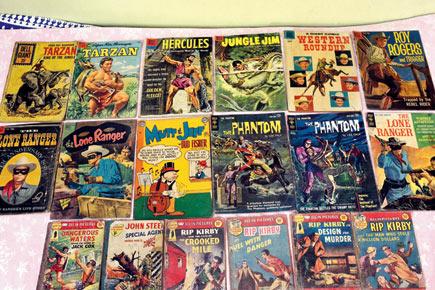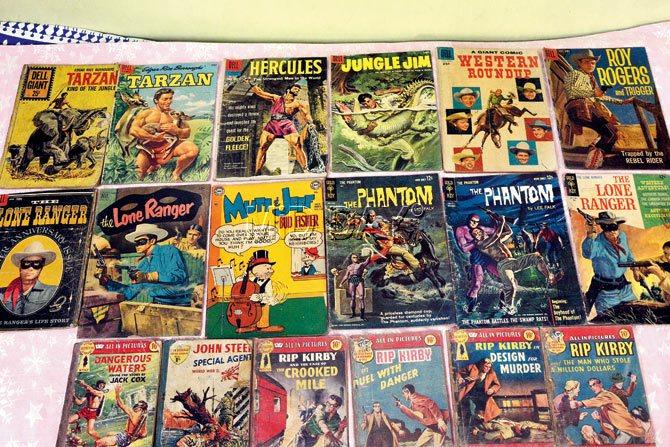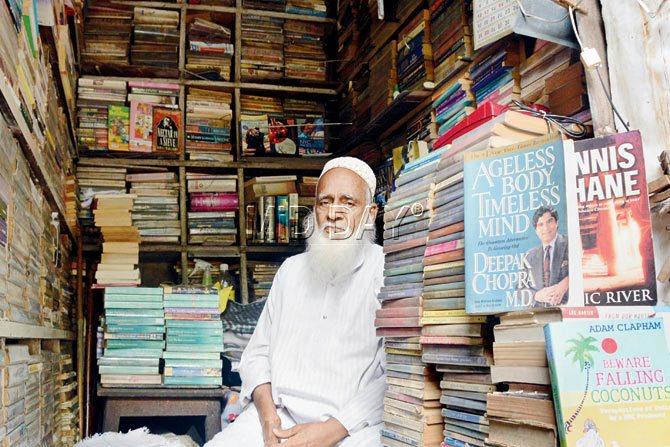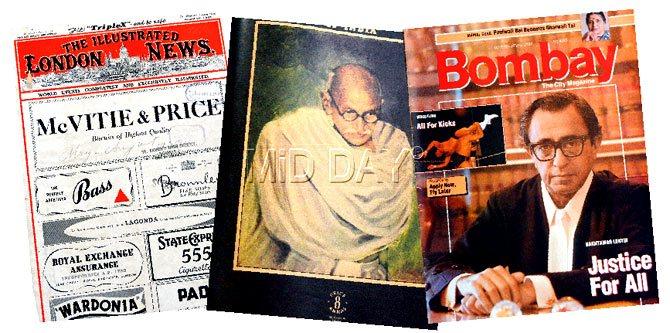Ahead of Teachers’ Day, meeting a mentor like Deepak Rao who shares his passion for “everything Bombay” is just the thing

About a lifetime,” he said to reviewers questioning how long it took to cull material for his seminal 2006 book, Mumbai Police. Urban historian Deepak Rao could well give that same answer to anyone asking after the enviable collections he has built of the rarest maps, publications, photographs, movie memorabilia and comic books.
The proof lies in teetering piles of these at every corner of the 67-year-old’s Queens Road home, bursting at the beams with treasures stashed since boyhood. In Standard 1 of St Xavier’s School, he thrived on sneaking in adventure comics with other brazen six-year-olds, despite this being strictly forbidden by the principal, Fr Richard Pereira. “He was as addicted to super heroes as we were, and read our confiscated copies of Tarzan and Lone Ranger,” says Rao laughing.
ADVERTISEMENT
 This ardent Bombay lover is my go-to guru for stories generously shared in sessions of engaging trivia over tea. “I must be the first to read your articles at 5 am,” he tells me. They’re early birds, Rao and his paperwalla Bhupendra Upadhyay, son of Ram Kishore who left the fields of Uttar Pradesh to start doorstep deliveries of newspapers in the island city.
This ardent Bombay lover is my go-to guru for stories generously shared in sessions of engaging trivia over tea. “I must be the first to read your articles at 5 am,” he tells me. They’re early birds, Rao and his paperwalla Bhupendra Upadhyay, son of Ram Kishore who left the fields of Uttar Pradesh to start doorstep deliveries of newspapers in the island city.

Rao holds up a cult title he claims even the St Xavier’s School principal was as great a fan of as his boys
Tight paper stacks make Rao’s wife Bhanu circle her hands in mock despair, quipping: “This is a storehouse, not a house.” His response is a volley of informative nuggets shot in hyper happy mode. Jumping rapid-fire from “Trams had a different charm, defining the city’s pace — slow and steady”, to “I explore the city simply by walking and cycling”, to a comparison I love: “You drive on Worli sea link but you stop on Marine Drive. There’s life on The Queen’s Necklace promenade. It belongs to us all.”

In this classic array, DC and Dell Comics (top row) precede – as they did chronologically too – the Gold Key series (middle row). At extreme left is The Lone Ranger silver anniversary edition which broke away from painted superhero covers to feature actor Clayton Moore who played the role on screen from 1949 to 1957 in the television series and two films from the same producers. All In Pictures: Rip Kirby (bottom row) was a favourite after Rao inherited this collection from his father. Pics/Sayed Sameer Abedi
The Bombay mania has genetic roots. Sanjiva Rao, his father, had a Master’s degree from the London School of Economics before joining the Intelligence branch of Bombay Customs in charge of anti-smuggling operations. Of Indumati, his mother, he says, “Unlike many 1940s women, she read history and literature voraciously, attended Tarkhadkar’s typing classes and worked for an insurance company.”

Abdullah Amir of Rita Circulating Library at New Marine Lines has kept Rao supplied with comic books for over 50 years since his childhood
Excitement floods their third generation living room as Rao displays vintage gems. Among the amazing editions is the 1946 Directory of Bombay Province: With Karachi and Hyderabad State, and 15 handsome volumes of The Illustrated London News. But, the word “illustrated”, which warms me instantly is on the masthead of The Illustrated Weekly of India, the magazine earning me journalism stripes. Rao is justifiably possessive of issues he has through its 1880-1993 run.

Left: The opening pages of The Illustrated London News in August 1945, printed ads for foreign whisky, cigarettes, biscuits and blades; Centre: The special issue of a national weekly after Gandhiji’s assassination, dated February 8, 1948, sold at 8 annas; Right: Justice Bakhtawar Lentin, one of Rao’s most admired personalities, graced a 1987 cover of the then popular magazine, Bombay
The energy peaks as he gingerly pulls out of impossibly tall ceiling spots, comic books from 1,000 cult titles. “All in Pictures: Rip Kirby was a favourite, serialised in The Evening News and a syndicated strip in the Bombay Chronicle,” Rao recalls. Social media-savvy fans get their fix of latest releases via apps; for him the thrill of this chase lasted till the 1970s when, he believes, the golden age of these books ended.
“Let’s visit the man I bought comics from as a kid,” he suggests. I’m incredulous. Yet, there he is, 83-year-old Abdullah Amir, proprietor of Rita Circulating Library at Marine Lines. Over fifty years ago, he stocked cutlery and Japanese fans ordered by the glamorous stars Suraiya and Nargis. Remembering Rao as a “badmaash baba”, the larger than life bookseller fills the tiny shop alcove. “I travel daily from my Mazagaon home,” he reveals, and invites me to browse. Faded Nick Carter and James Hadley Chase paperbacks rub spines with Enid Blyton’s Noddy. Inexplicably, Kamala Markandaya’s Nectar In A Sieve pops up too. “Who buys these anymore?” Amir rues rhetorically, adjusting broken wooden clips which string his wares.
Dulled ink stamps on inner jacket flaps featuring Roy Rogers and Gene Autry trigger memories of Westerns blazing screens in plush halls. Exhibiting MGM movies for the first time in town, Metro opened in June 1938 to protests from Parsi distributors monopolising the theatre trade (Rao has a photograph of this event). The community soon turned staunch American film buffs. Ahead in queues, booking seats for matinees between 60 paise and Rs 1.60 to pricier night shows, they thrilled to the MGM lion’s roar. “Metro’s publicity line was ‘Every seat a cool retreat’, when it was air-conditioned,” Rao remarks. Regal stuck to the curiously syrupy – ‘Our true intent is all for your Delight’.
Stroll around any cinema with Rao to realise he’s as deeply in love with neighbouring cafés, reeling off fascinating facts about them. Talk of five eateries topping his list softens those restless eyes. Only the last two survive. Closest home, MG Café was a childhood haunt in Pearl Mansion two gates away. “Mathurdas Goculdas, the owner, held Licence No. 1 for foreign liquor at Vine Vault across the Town Hall. For 45 years MG served the best mutton samosas and fish curry ever stirred by Goan cooks.” Famous for four ‘couple rooms’, it had a Kwality stall after that ice cream was introduced in 1957 – vanilla sticks for 25 paise, double price for Chocobar.
On Churchgate Street, as Veer Nariman Road was known, Rao frequented “Little Gourdon” for pastries and patties. Though they came in appetising platefuls, patrons were billed just for those consumed. “Big Gourdon” beside boomed jazz as you scanned the day’s specials crisply typed on a white card. Six-course meals cost R9 as the 1940s breezed into 1950. Expat Emile Gourdon took culinary art seriously, as he did his post as honorary secretary of the Bombay Provincial Hockey Association. Lettuce salads tossed in garlic and olive oil were a worthy prelude to succulent steaks drowned in browned onions.
Rao’s friend Cyrus Irani’s father, Behram Khodaram, had invested 25 per cent partnership in Grand Oriental Hotel on Grant Road – “It faced Super Cinema, so customers on the restaurant terrace heard the trrrrrrrrring of metal openers clinked over soda bottles in the interval.” A rolling flip-board announced items available: patra ma pomfret and boomla (fried Bombay Duck), to humble lentils like masoor and titori whose lingering spicy taste regulars swore by.
“Lodgers paying R50 per day a floor above were Gujarat cop officers attending matters come up in Bombay courts, or diamond merchants,” says Rao. “And taporis,” adds Irani. “Kind employers like dad refused to raise the rate of a six-loaf bread laadi by 25 paise.” Passersby can still see the portico remains of Grand Oriental which downed shutters in 1990.
The hangout Rao can be caught at almost daily is Cafe Military in Tamarind Lane, Fort, where MF Husain would wander in for morning half portions of kheema while fellow artist Altaf sat sipping beer. Thursday teas at Military, replete with brun and brio, inspired the poet Arun Kolatkar: ‘The cockeyed Shah of Iran watches the cake/decompose carefully in the cracked showcase/distracted by a fly on the make/as it finds in a loafer’s wrist an operational base.’
At 103 years, Sassanian Restaurant in Dhobi Talao continues mixing melt-in-the-mouth mawa and plum cakes. Its fluffy chicken puffs were a hit with actresses Mumtaz and Helen, in an era when Bollywood beauties stayed stunning even as they consumed calories with gusto. Peppermints and sugared almonds on offer in its glass jars, this was Rao’s hangout because of the butter. “In the Polson brand reign, Sassanian sold the largest quantities. Margarine was used elsewhere but Polson packs opened here in front of satisfied customers. A coupon was tagged to each, and four won you free custard powder!”
Always immersed in researching a Bombay book (Mumbai’s Water is the second title he has authored), Rao’s next examines its war years, 1939-1945, from a police vantage point. Teaching the sensitisation course, ‘A surface exploration of Greater Bombay’ at Heras Institute, he says, “We should view heritage beyond the Gateway and museum. Some students have marvellously covered Byculla to Bandra, Malad to Kanjurmarg. I do urge youngsters, ‘Bambai ke deewane bano’ – be mad about your city!”
Author-publisher Meher Marfatia writes fortnightly on everything that makes her love Mumbai and adore Bombay. You can reach her at mehermarfatia@gmail.com
 Subscribe today by clicking the link and stay updated with the latest news!" Click here!
Subscribe today by clicking the link and stay updated with the latest news!" Click here!







